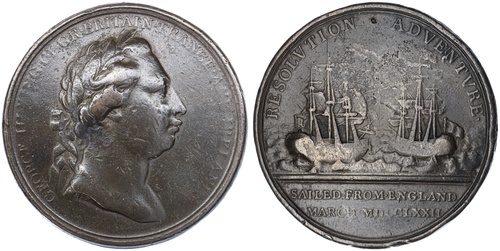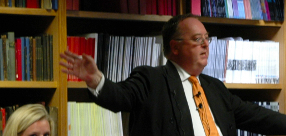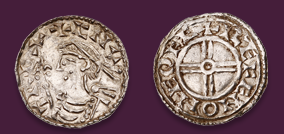
Auction: 23129 - Spink Numismatic e-Circular 33: British and World Coins - e-Auction
Lot: 10060
Captain Cook's Second Voyage to the Pacific Ocean, 'Resolution and Adventure' or 'Otaheite' AE Medal, 1772, [by J. Westwood Sr.], GEORGE . III . KING . OF . GR . BRITAIN . FRANCE . AND . IRELAND ETC, laureate head right of George III, rev. RESOLVTION ADVENTVRE., the two frigates, Resolution and Adventure viewed from astern, SAILED FROM ENGLAND MARCH MDCCLXXII in exergue in two lines, 44mm, 31.74g, 12h (Betts 552; BHM 165; Eimer 744b), contact marked and with a tooled mark to the reverse at 12 o'clock, smoothed and rubbed to the devices, thus fine, nonetheless an ever popular and scarcely encountered striking
It is understood some 2,000 of these Medals were struck and delivered aboard the Resolution for her leaving Plymouth on 13th July 1772.
They were distributed across the South Pacific islands, including New Zealand and Tahiti. Writing in his journal in January 1773, Cook records delivery Medals on the island of Tasmania:
'Some of our present group wore, loose, round their necks, three or four folds of a small cord, made of the fur of some animal; and others of them had a narrow slip of the kangaroo skin tied round their ankles. I gave to each of them a string of beads and a medal, which I thought they received with some satisfaction.'
Those that remained undistributed during the Second journey of exploration were taken back aboard the Resolution for Cook's third and final voyage. Cook departed on 1 July 1776 on his way back to New Zealand and Tasmania before discovery of Hawaii and his exploration of the Pacific coast of North America from Oregon to Alaska. Adams records only one delivery of medals to residents of North America, at Nootka Sound, where Cook arrived on 30 March 1778. Cook was greeted by Chief Maquinna and, according to an entry in his journal:
'...a great many canoes filled with the Natives were about the ships all day, and a trade commenced betwixt us and them, which was carried on with the Strictest honisty on boath sides [sic]. Their articles were the Skins of various animals, such as Bears, Wolfs, Foxes, Dear, Rackoons, Polecats, Martins and in particular the Sea Beaver, the same as is found on the coast of Kamchatka.'
Adams notes that:
'...the Medals were not conveyed with any ceremony but, rather, were parcelled out along with beads, flints, nails, and other trade goods of nominal value, the same items that most likely purchased the bounty in skins that day that later were resold in Macao for $10,000 in 1779.'
The Medal is a landmark item as it ranks among the first trade items in the English-Pacific trade and as a token of friendship, similar to the various Peace Medals struck for the North American Indian Chiefs in the years that followed.
There are exacting records for the striking of these medals and it would seem that two specimens were struck in gold, 106 in silver and 2,000 in bronze. Most of the bronze medals are unmounted, such as this example. Two reverse dies were produced for the striking of the bronze medals, the second die having been used to produce this example. The reverse of this second issue was struck on a heavier flan and shows the anchor in a vertical rather than horizontal position.
The obverse die is common to both strikings and carries the initials 'B:F' on the truncation of George III, indicating that a partnership between Mathew Boulton and John Fotherfill was responsible for the manufacture of the medals. It is in fact generally believed that the dies were engraved by John Westwod, whose signature does not appear.
Subject to 20% VAT on Buyer’s Premium. For more information please view Terms and Conditions for Buyers.
Estimate
Starting price
£1000




